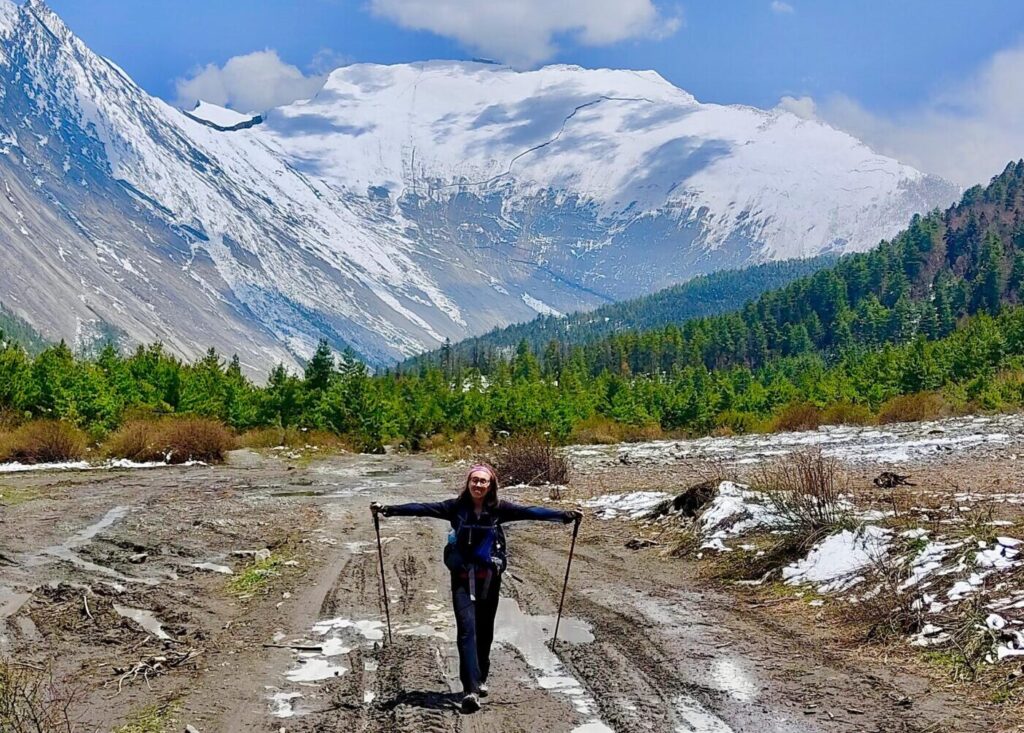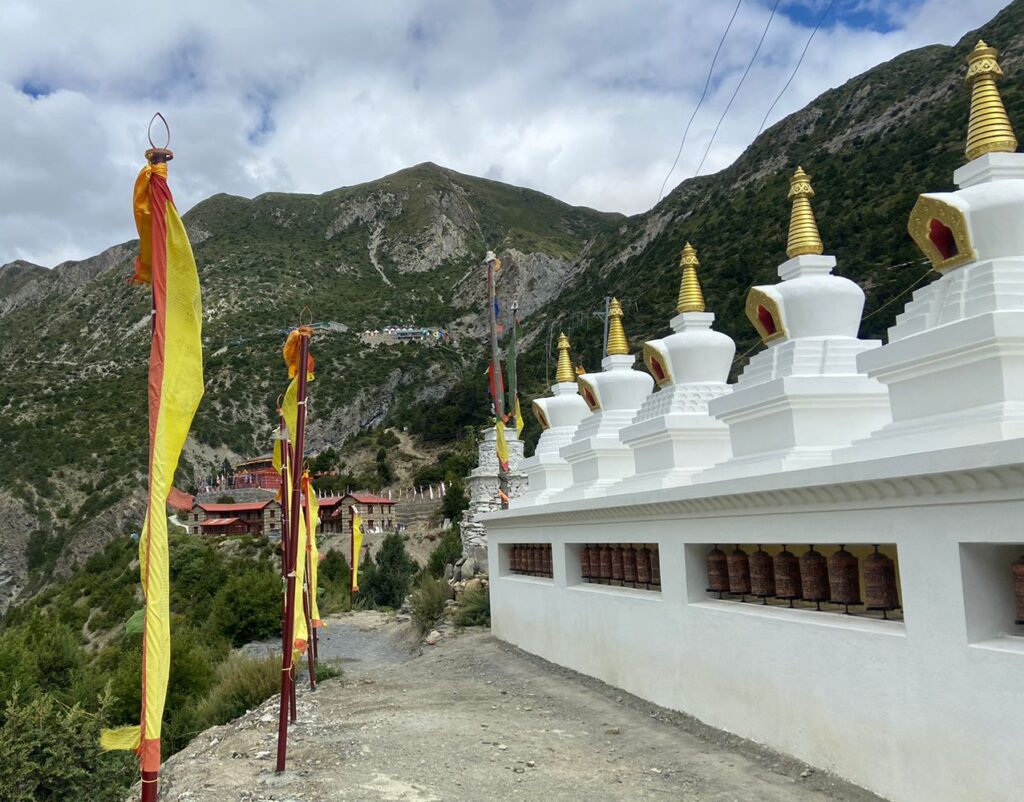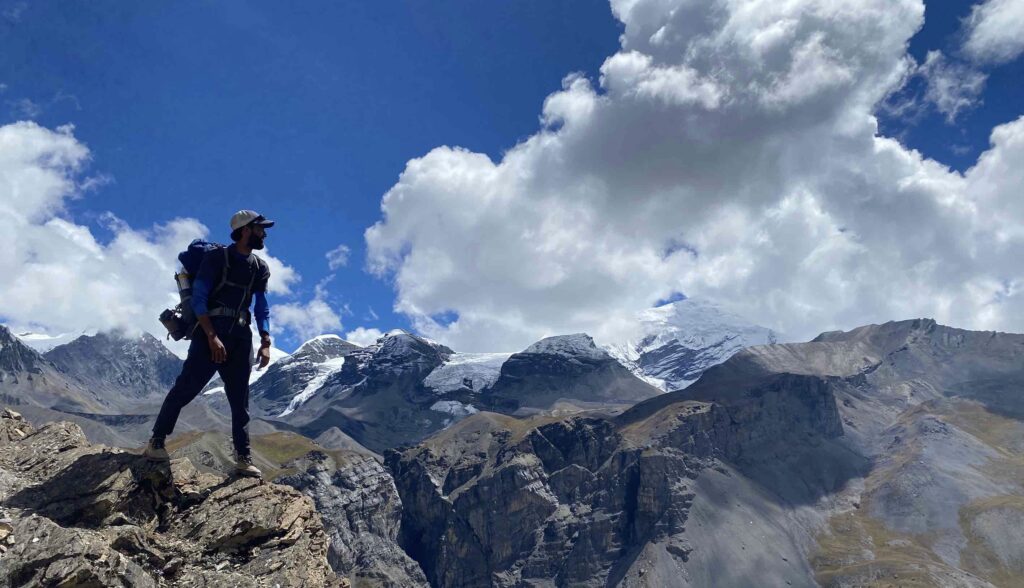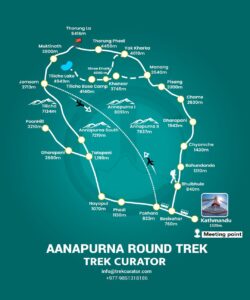Annapurna circuit trek with Ghorepani
Be the first to review!
Overview
If you’re seeking a Himalayan adventure that captures the very soul of Nepal, where nature, culture, and challenge all come together. The Annapurna Circuit Trek with Ghorepani should be at the top of your list. This iconic trek circles the majestic Annapurna Massif, leading you through a tapestry of landscapes, from lush subtropical forests and rice paddies to alpine meadows and high mountain deserts.
What sets this trek apart is not just its diversity in terrain, but also in people and culture. As you ascend, you’ll witness the gradual transformation of ethnic groups, languages, architecture, and even food. The trek typically spans 12 to 20 days, depending on your chosen route and pace, covering approximately 160 to 230 km. With Trek Curator, you will get a customized itinerary that balances both adventure and acclimatization. We ensure safety without compromising the thrill.
Trailheads & Starting Part of the Trek
The classic Annapurna Circuit Trek with Ghorepani begins at Besisahar, a small but bustling town that serves as the gateway to this legendary trail. However, thanks to road developments, many trekkers now begin from Chamje. Chame, trimming off the dusty road section and diving straight into the mountains.
The early days of the trek wind through beautiful valleys, riverside trails, and terraced hillsides lined with traditional Gurung and Tamang villages. These first few days offer a relatively gentle climb, ideal for warming up your legs and lungs. Expect to walk beside the roaring Marsyangdi River, cross thrilling suspension bridges, and pass under waterfalls that cascade right across the trail.
At Trek Curator, we ensure your start is well-paced and immersive. Our team handles logistics so you can focus on what matters, soaking in the view and adjusting to the altitude.
Manang Acclimatization: Slow Down to Soar High
Manang (3,540m) is more than just a rest stop. It is a critical acclimatization point and a charming mountain town nestled in the lap of giants. After several days of steady ascent, spending a full day here helps your body adjust to the thinning air before tackling higher altitudes.
While you’re in Manang, you are not just killing time, you’re exploring. Take a side hike to Gangapurna Lake, visit the ancient Braga Monastery, or trek up to Ice Lake (Kicho Tal). These hikes provide both acclimatization benefits and panoramic views that are simply unforgettable.
Trek Curator organizes acclimatization in a way that feels like an experience, not a pause. You’ll receive guidance on optional hikes, dietary suggestions, and even cultural insights from our experienced local guides.
Crossing Thorong La Pass: The Ultimate High
Reaching Thorong La Pass (5,416m) is, without question, the highlight and the biggest challenge of the Annapurna Circuit. It is the highest point of the trek, and crossing it requires an early start (usually around 4 AM), a steady pace, and a lot of determination.
But trust us, it is worth every step. As you reach the summit, you will be greeted by flapping prayer flags, a 360-degree Himalayan panorama, and a deep sense of achievement. The sense of camaraderie among trekkers at the top is heartwarming, especially after such a demanding ascent.
Safety is paramount here, and Trek Curator doesn’t leave anything to chance. We monitor weather conditions daily, guide you with experienced hands, and always have contingency plans ready in case of altitude-related issues.
Muktinath and Pokhara: Spiritual Closure and Well-Earned Comfort
The descent from Thorong La leads you to Muktinath, a sacred pilgrimage site revered by both Hindus and Buddhists. Here, flames emerge from natural gas vents and icy holy water flows from 108 spouts. Whether or not you’re spiritual, there is something profoundly peaceful about this place.
From Muktinath, the trail joins with a road that eventually leads you to Jomsom. From where many trekkers choose to fly or drive to Pokhara, Nepal’s lakeside paradise. After days of high-altitude trekking, Pokhara offers the perfect setting to unwind: massage centers, cozy cafes, serene lakeside strolls, and, of course, celebratory dinners with fellow trekkers.
With Trek Curator, your journey does not end at the pass. It continues smoothly to Pokhara, with your comfort, logistics, and little celebratory touches taken care of.
Ready to Trek the Circuit?
The Annapurna Circuit with Ghorepani is not just a trek; it is a story you will tell for a lifetime. And with Trek Curator by your side, it becomes a seamless, safe, and soul-stirring adventure. Whether you’re a first-time trekker or a seasoned high-altitude hiker, we will tailor the experience to suit your pace and preferences.
Let Trek Curator craft your Himalayan story. Get in touch today.
✅ What's Included:
- Airport Transfers (Pick-up & Drop-off)
- Kathmandu to Pokhara Transport (Flight/Bus)
- Accommodation (Teahouses/Lodges during the trek)
- Meals (Breakfast, Lunch & Dinner during the trek)
- Trekking Permits (ACAP & TIMS)
- Professional Guide & Porter (Guide with First Aid Kit)
- Necessary Trekking Equipment (Sleeping Bag & Down Jacket on rent)
- Annapurna Conservation Area Entry Fees
- Emergency Support (Basic First Aid & Oxygen Cylinder
❌ Price Excludes:
- International Flights (To/From Nepal)
- Nepal Visa Fees
- Travel Insurance (Mandatory for high-altitude trekking)
- Personal Expenses (Snacks, drinks, hot showers, Wi-Fi, battery charging)
- Meals in Kathmandu & Pokhara (Except breakfast at hotels)
- Trekking Gear (Personal clothing, boots, trekking poles, etc.)
- Tips for Guide & Porter (Customary but not mandatory)
- Emergency Evacuation & Helicopter Rescue (If required)
- Extra Accommodation Costs (Due to delays, weather, or personal reasons)
Itinerary Overview
Day 1: Arrival at Tribhuvan International Airport in Kathmandu and Transfer to Hotel (1,400m)
Day 2: Drive to Dharapani from Kathmandu (1,960m) – Approx. 220 km / 9-10 hours
Day 3: Trek to Chame (2,650m) – Approx. 15 km / 5–6 hours
Day 4: Trek to Upper Pisang (3,300m) – Approx. 13.5 km / 5–6 hours
Day 5: Trek to Ngawal (3,660m) – Approx. 11 km / 5–6 hours
Day 6: Trek to Manang via Bhraka (3,540m) – Approx. 9 km / 4–5 hours
Day 7: Acclimatization Day at Manang Village (3,540m)
Day 8: Trek to Yak Kharka (4,050m) – Approx. 10 km / 4–5 hours
Day 9: Trek to Thorong Phedi (4,525m) – Approx. 7 km / 3–4 hours
Day 10: Trek to Muktinath via Thorong La Pass (5,416m) – Approx. 15 km / 7–9 hours
Day 11: Drive to Tatopani via Jomsom (1,200m) – Approx. 6–7 hours by shared vehicle
Day 12: Rest Day at Tatopani – Relax in Natural Hot Springs (1,200m)
Day 13: Trek to Ghorepani (2,860m) – Approx. 17 km / 7–8 hours
Day 14: Sunrise at Poon Hill (3,210m), Trek to Birethanti, and Drive to Pokhara – Approx. 15 km trek / 1.5 hr drive
Day 15: Drive Back to Kathmandu – Approx. 200 km / 6–7 hours
Day 16: Final Departure
Detail Itinerary
Arrival at Tribhuvan International Airport in Kathmandu and Transfer to Hotel (1,400m)
Welcome to Nepal! Upon your arrival at Tribhuvan International Airport in Kathmandu, a friendly representative from Trek Curator will greet you with a warm Nepali welcome and assist with your transfer to a comfortable hotel in Thamel, the vibrant tourist hub of the city. The rest of the day is yours to relax and recover from your flight. You can explore the bustling lanes filled with trekking shops, local eateries, and cultural landmarks. In the evening, join us for a short pre-trek briefing where you will meet your guide and go over the journey ahead.
Drive to Dharapani from Kathmandu (1,960m) – Approx. 220 km / 9-10 hours
Your adventure begins early as we set off on a scenic private vehicle journey from Kathmandu to Dharapani, located in the Manang district. The drive initially follows the Prithvi Highway alongside the Trishuli and Marsyangdi Rivers, offering glimpses of terraced fields, distant snow-capped peaks, and traditional villages. After a lunch stop en route, the road becomes more rugged as we ascend through winding mountain paths past Besisahar and Jagat before reaching Dharapani by late afternoon or early evening. You will check into a cozy teahouse, unwind, and enjoy a hearty meal as you prepare to start trekking tomorrow.
Trek to Chame (2,650m) – Approx. 15 km / 5–6 hours
After a filling breakfast, you will begin your first day of trekking through beautiful pine forests, climbing steadily along the Marsyangdi River. The trail passes through Bagarchhap, where you’ll notice a shift in architecture and culture as Tibetan influences begin to appear. Continuing past Danaque, a steady climb leads to Timang, a perfect lunch spot with stunning views of Manaslu (8,163m). From here, the trail becomes gentler as you pass by apple orchards and peaceful forests before arriving in Chame, the administrative center of Manang. Here, enjoy your first views of Lamjung Himal, relax in the hot springs nearby, and rest in a well-equipped lodge.
Trek to Upper Pisang (3,300m) – Approx. 13.5 km / 5–6 hours
Today’s trek leads through a lush forest as you gradually ascend to Bhratang, a scenic riverside village known for its apple farm. After crossing a dramatic suspension bridge over the Marsyangdi, you begin a steady climb through a narrow gorge where the trail has been carved into the cliffside, a thrilling highlight. The path eventually opens into the wide valley of Dhukur Pokhari, where you will stop for lunch. After a brief rest, you will head up towards Upper Pisang, a traditional village offering excellent views of Annapurna II and IV. The higher altitude here supports acclimatization and sets the stage for the cultural richness ahead.
Trek to Ngawal (3,660m) – Approx. 11 km / 5–6 hours
Start your day with a gentle climb through arid terrain, passing prayer wheels and ancient mani walls. This high-altitude route via Ghyaru is tougher but incredibly rewarding, with panoramic views of the Annapurna range, Tilicho Peak, and the deep valley below. Ghyaru makes a great spot for a tea break while soaking in the views. From here, the trail continues through the upper route to Ngawal, a village steeped in Tibetan Buddhist culture. Unlike the lower route, this path is quieter, more authentic, and helps with acclimatization. In Ngawal, enjoy your evening in a traditional teahouse surrounded by the serenity of the Himalayan highlands.
Trek to Manang via Bhraka (3,540m) – Approx. 9 km / 4–5 hours
Today’s trail gently descends from Ngawal, gradually merging with the main trail near Braka (Bhraka), home to an ancient cliffside monastery. We’ll visit the Braka Monastery, one of the oldest in the region, before continuing to Manang, a bustling village nestled beneath the towering peaks of Annapurna III, Gangapurna, and Tilicho. The walk is relatively easy today, giving your body time to adapt to the altitude. Lunch will be enjoyed either in Braka or upon reaching Manang. Upon arrival, take time to rest, stroll through the village, and prepare for tomorrow’s acclimatization hike.
Acclimatization Day at Manang Village (3,540m)
To adjust properly to the altitude, today is a rest and acclimatization day in Manang. But don’t worry, you won’t be idle. After breakfast, join a short but steep acclimatization hike to either Gangapurna Lake or the 100 Rupee Lama viewpoint, which offers incredible panoramic views of the glaciers and peaks. For the more adventurous, a longer hike to Ice Lake (Kicho Tal) is also an option, taking about 5–6 hours round trip. The day is designed to help your body prepare for the high pass ahead. Spend your afternoon exploring the Himalayan Rescue Association center, chatting with locals, or simply relaxing with a warm drink in a lodge overlooking the mountains.
Trek to Yak Kharka (4,050m) – Approx. 10 km / 4–5 hours
With the terrain becoming more barren, today’s trek moves into alpine zones where you’ll see grazing yaks and dry stone houses. The trail ascends gently through Tengi and Gunsang, passing juniper bushes and open meadows. After crossing a wooden bridge over the Jarsang Khola, you’ll arrive in Yak Kharka, a small collection of lodges set against the rugged Himalayan backdrop. Lunch is usually enjoyed at Gunsang or after arriving in Yak Kharka. The shorter trek today allows for more rest at higher altitudes, supporting better acclimatization.
Trek to Thorong Phedi (4,525m) – Approx. 7 km / 3–4 hours
Today’s journey is relatively short but crucial as you approach the foot of Thorong La Pass. The trail climbs gradually through rocky terrain, crossing a landslide-prone section with care before reaching Thorong Phedi, the base camp for tomorrow’s pass crossing. Some may choose to hike an hour further to High Camp (4,800m) for a better head start the next day, though we recommend resting in Phedi for better sleep and oxygen levels. After lunch, take it easy, hydrate well, double-check your gear, and sleep early in preparation for the big day.
Trek to Muktinath via Thorong La Pass (5,416m) – Approx. 15 km / 7–9 hours
Rise early, around 4 AM, for a headlamp-lit ascent to Thorong La Pass, the highest point of the trek at 5,416m. The climb is steady but steep and can be challenging due to the cold and thin air. After about 3–5 hours of climbing, you will reach the top, greeted by fluttering prayer flags and breathtaking 360° mountain views. After photos and celebration, begin your descent to Muktinath (3,760m), a sacred pilgrimage town revered by both Hindus and Buddhists. Lunch is usually taken en route at Charabu, halfway down. Muktinath’s sacred temple and eternal flame are fascinating to visit in the evening after your long day.
Drive to Tatopani via Jomsom (1,200m) – Approx. 6–7 hours by shared vehicle
This morning, enjoy a hot breakfast before boarding a shared local jeep for a bumpy yet scenic drive through the Kali Gandaki Gorge, the world’s deepest. You will pass through Jomsom, the windy administrative hub of Mustang, and descend gradually through Marpha, famous for its apples and brandy. Continuing further south, the landscape transforms from barren to subtropical as you reach Tatopani, meaning “hot water.” After checking in, soothe your tired muscles in the natural hot springs by the river, an absolute treat after the previous day’s high-altitude exertion.
Rest Day at Tatopani – Relax in Natural Hot Springs (1,200m)
Today is all about relaxation and recovery. After days of trekking through harsh terrain and thin air, Tatopani offers a warm, tropical climate, plenty of fresh fruit, and, of course, its famous hot springs. Take your time to rest, wash clothes, read, or sip a fresh fruit juice at a riverside cafe. If you’re up for a short walk, the surrounding villages and farmland offer peaceful exploration. Trek Curator ensures you enjoy this well-earned break before the final stretch of your adventure.
Trek to Ghorepani (2,860m) – Approx. 17 km / 7–8 hours
Leaving Tatopani, the trail begins a long ascent through rhododendron forests and traditional Magar villages like Sikha and Chitre. After a lunch stop midway, the climb becomes steeper as you gain over 1,600 meters in altitude. You will arrive in Ghorepani, a charming ridge-top village popular for its sunrise views. Nestled within the Annapurna Conservation Area, Ghorepani is surrounded by rhododendrons that bloom vividly in spring. Your lodge for the night will offer comfortable accommodations and a stunning mountain backdrop.
Sunrise at Poon Hill (3,210m), Trek to Birethanti, and Drive to Pokhara – Approx. 15 km trek / 1.5 hr drive
Rise before dawn and hike for about 45 minutes to Poon Hill, one of the most celebrated viewpoints in Nepal. As the sun rises behind Annapurna South, Hiunchuli, and Dhaulagiri, watch the snow-capped peaks bathe in golden light. After capturing these unforgettable moments, return to Ghorepani for breakfast and begin your final descent. The trail winds down through dense forest to Ulleri, known for its steep stone steps, and then eases out towards Birethanti. From there, a private vehicle awaits for a short drive to Pokhara (827m), where a hot shower, soft bed, and lakeside dining await you.
Drive Back to Kathmandu – Approx. 200 km / 6–7 hours
After breakfast by Phewa Lake, you will board a comfortable tourist bus for the drive back to Kathmandu. The road retraces the route through green hills, terraced farms, and riverside villages. You’ll arrive in the capital by late afternoon and be transferred to your hotel. In the evening, Trek Curator invites you for a farewell dinner at a local Nepali restaurant, where you can reflect on your journey, share stories, and celebrate your achievements.
Final Departure
After breakfast, our team will assist with your airport transfer. As you say goodbye to Nepal, we hope the memories of the Annapurna Circuit, the mountains, the people, and the sense of accomplishment stay with you forever. Trek Curator thanks you for choosing us to be part of your Himalayan journey, and we hope to welcome you back for another adventure soon. Top of Form
Additional Information:
Landscape and Transportation
The Annapurna Circuit offers one of the most diverse landscapes in the Himalayas. Beginning in the lush, terraced foothills near Kathmandu and gradually rising to the arid, windswept terrain of the trans-Himalayan region, the trek covers everything from subtropical forests to alpine meadows and high mountain deserts. You will witness dramatic elevation shifts, ancient villages, deep gorges, and glacial rivers along the way.
Transportation is arranged with comfort and safety in mind. All long-distance travel, such as the drive from Kathmandu to Dharapani and return from Pokhara, is in private or tourist-standard vehicles arranged by Trek Curator, ensuring a smooth and scenic journey through Nepal’s breathtaking countryside.
Trekking Guides, Porters, and Services
At Trek Curator, we believe that the people who accompany you on the trail are just as important as the trail itself. That is why we assign experienced, licensed trekking guides who are not only knowledgeable about the terrain, culture, and safety measures but also fluent in English and trained in high-altitude first aid.
Our friendly porters will carry your main luggage (A duffle Bag is mandatory), allowing you to walk lightly and enjoy the journey more fully. We strictly follow ethical porter treatment policies, each porter carries a manageable load, and is insured. Guides and porters ensure your safety, share stories, and take care of logistics, so you can focus on the adventure.
Meals and Accommodation
Throughout the trek, you will be accommodated in cozy mountain lodges and teahouses, all pre-booked by the Trek Curator. While the rooms are generally basic and twin-shared, they are clean and safe, and often offer spectacular mountain views.
Meals on the trek include a mix of traditional Nepali fare like dal bhat, Tibetan-inspired dishes such as momos and Thukpa, and a variety of continental options like pasta, pancakes, and porridge. You will be well-nourished with three meals a day during the trek, and we also accommodate vegetarian and special dietary requirements upon request. In Kathmandu and Pokhara, your stay will be in comfortable tourist-standard hotels with modern amenities.
Extension to Tilicho Lake
If you’re looking to enhance your Annapurna adventure, an extension to Tilicho Lake (4,919m), one of the world’s highest lakes, is a must. This detour adds an extra 2–3 days to your itinerary and takes you through rugged, surreal landscapes with incredible views of Tilicho Peak and surrounding giants. The trail from Manang to Tilicho Base Camp and onward to the lake is more demanding, but the reward is unmatched: a pristine turquoise lake nestled in a glacial basin, far from the crowds. Trek Curator can seamlessly customize your itinerary to include this detour with all logistics, safety measures, and accommodations arranged.
Cautions on Landslide-Prone Areas
Some sections of the Annapurna Circuit, especially between Dharapani and Chame, and Yak Kharka to Thorong Phedi, are known for landslides and rockfall, particularly after monsoon rains. While these risks are seasonal and weather-dependent, Trek Curator takes every precaution, including checking trail conditions daily, adjusting routes when necessary, and ensuring guides are equipped with radios and local contacts for real-time updates. We advise trekkers to follow their guide’s instructions closely, stay on marked trails, and never trek alone in risk-prone sections. Your safety is our top priority.
Booking Policy and Required Documents
Booking your Annapurna Circuit trek with Trek Curator is straightforward and transparent. To confirm your trek, a 20–30% deposit is required upon booking, with the balance payable upon arrival in Kathmandu. We accept international bank transfers, cards, or cash.
For documentation, you will need a valid passport (with at least 6 months’ validity), two passport-sized photos, and travel insurance. Our team will handle all necessary trekking permits, including the Annapurna Conservation Area Permit (ACAP) and the TIMS card. Once booked, you will receive a detailed packing list, itinerary, and preparation guide to help you get ready.
Emergency Evacuation
Although rare, emergencies at high altitudes can happen. That is why Trek Curator includes a robust emergency plan with every trek. All our guides carry first aid kits and are trained in altitude sickness response. In serious situations, we coordinate immediate evacuation to Pokhara or Kathmandu, depending on the location. Trekkers must carry comprehensive travel insurance that covers high-altitude trekking (up to 5,500m) and emergency evacuation. With Trek Curator, your health and safety come first, and we will always be just one call away.
EQUIPMENTS
- Warm insulated jacket
- Waterproof jacket & pants
- Trekking shirts & pants
- Thermal base layers
- Wool/fleece mid-layer
- Warm hat
- Gloves
- Sturdy trekking boots
- Trekking socks
- Camp shoes/slippers
- Trekking poles
- Headlamp
- Sunglasses
- Water bottles
- Water purification
- Quick-dry towel, wet wipes, and hand sanitizer
- Sunscreen
- Personal medications
- Diamox
- Painkillers
- Electrolyte/salt packets
- TIMS Card
- Annapurna Conservation Area Permit (ACAP)
- Travel insurance






